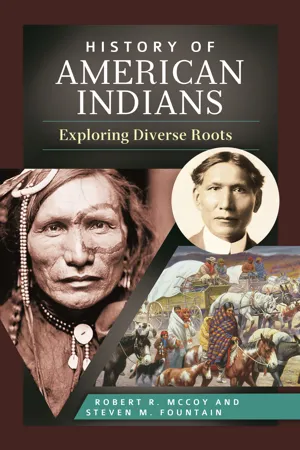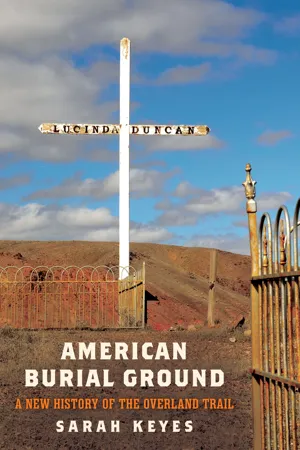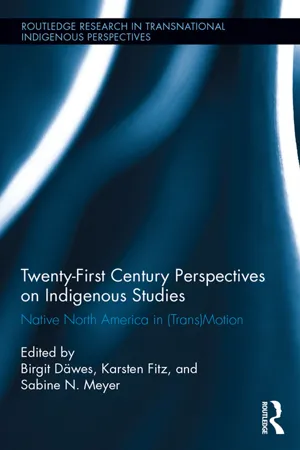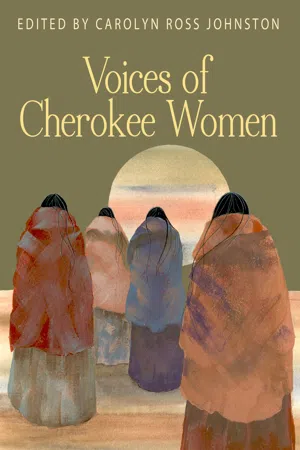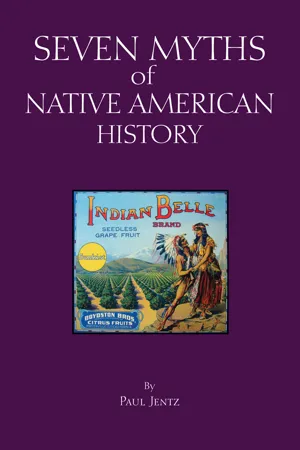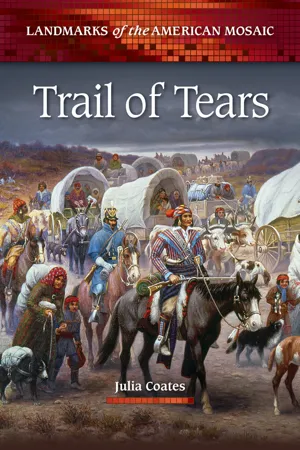History
Trail of Tears
The Trail of Tears refers to the forced relocation of Native American tribes, including the Cherokee, from their ancestral lands in the southeastern United States to designated Indian Territory in present-day Oklahoma. This tragic event, which took place in the 1830s, resulted in the deaths of thousands of Native Americans due to exposure, disease, and starvation during the arduous journey.
Written by Perlego with AI-assistance
Related key terms
Related key terms
1 of 4
Related key terms
1 of 3
10 Key excerpts on "Trail of Tears"
- eBook - ePub
Monuments to Absence
Cherokee Removal and the Contest over Southern Memory
- Andrew Denson(Author)
- 2017(Publication Date)
- The University of North Carolina Press(Publisher)
This widespread enthusiasm for the national trail raises an obvious, but important, point: Cherokee removal was simply not a topic that inspired public controversy. Both Cherokees and non-Indians proved eager to commemorate removal, and they agreed on the general meaning of the event. Removal was a tragic injustice caused by greed and a disregard for Cherokee rights. It was a shameful episode that contemporary Americans needed to remember, in order to guard against such abuses in the future. Local communities competed for the privilege of depicting the disgraceful treatment of the Cherokees by the United States, and heritage advocates only grew angry when it seemed the Park Service might overlook the role played by their particular town or county in this shameful episode. Few people, it seems, objected to the idea of memorializing the Trail of Tears in the first place.This lack of opposition appears noteworthy when considered in light of several well-known historical controversies fought during this same period. The development of the national trail coincided with the so-called history wars, a series of bitter public arguments over the representation and teaching of the American past. Several of the most conspicuous of these debates involved Native Americans and the history of colonization and American expansion. In 1991, for instance, the Smithsonian’s National Museum of American Art provoked outrage with its exhibit The West as America , which offered a critical examination of iconic images of the American frontier. The exhibit paired works by artists like Frederick Remington and Charles Bird King with interpretive panels that called attention to the ways in which traditional frontier images served to justify violent conquest and exploitation. Political conservatives condemned the exhibit as anti-American, characterizing it as a radical assault on the nation’s founding principles. This criticism became part of a broader backlash against “political correctness” and multicultural education.67 Around the same time, planning for the Columbus Quincentenary provoked even greater public debate, as Native Americans protested observations that appeared to celebrate colonialism and the destruction of indigenous peoples. Indigenous activists declared 1992 a “year of mourning” and condemned Columbus as a facilitator of genocide, slavery, and environmental destruction. Conservative commentators responded with predictable anger, attacking the protests as the work of radicals. The controversy effectively derailed the quincentenary before it even began, as public history institutions and funding agencies began to avoid projects related to an event that now seemed dangerously contentious.68 - eBook - ePub
Journeys Through American History: Volume I
Native Americans and Revolutionary Times
- James T Parks(Author)
- 2020(Publication Date)
- European Creative Communication Inc(Publisher)
INDIAN REMOVAL IN THE 19TH CENTURY:As Europeans continued flooding into America in the 19th century, our federal government began displacing Native Americans from their homelands by moving them to reservations west of the Mississippi River. This section retraces the paths followed by one of those tribes, the Cherokee, along what came to be known as The Trail of Tears, because of the resulting deaths and hardships.Passage contains an image THE CHEROKEE Trail of Tears
Missionary Daniel Butrick kept a journal of his travels with the Cherokee People as they were force-marched to Indian Territory during the winter of 1838-39. It is one of the saddest episodes in American history, with the depths of despair grippingly described by him in this entry: “… the government might more mercifully have put to death everyone under a year or over sixty; rather it had chosen a more expensive and painful way of exterminating these poor people. ”BREAKING AWAY FROM THE BELTWAYIn pre-Columbian times, the Cherokee People’s land stretched from the Ohio River to present-day Kentucky, Tennessee, North Carolina, South Carolina, Georgia, and Alabama. But by the early 1800s, various treaties had reduced Cherokee land to a fraction of their former size. At the same time, European diseases devastated much of the Cherokee Nation. Those who survived adopted many aspects of European culture and enterprise, including farming, a written language, a court system, a printed newspaper, and even Christianity. Cherokee settlements looked and functioned much the same as white settlements of the day. However, in 1828, gold was discovered on Cherokee land in North Georgia, and white settlers began ignoring legal Cherokee boundaries. By 1830, the Cherokee had lost any legal claim to their lands. That year, Congress passed the Indian Removal Act, and President Andrew Jackson signed it into law; he had long advocated Indian removal to lands west of the Mississippi River. - eBook - ePub
All Things Dickinson
An Encyclopedia of Emily Dickinson's World [2 volumes]
- Wendy Martin Ph.D.(Author)
- 2014(Publication Date)
- Greenwood(Publisher)
In addressing the 21st Congress, President Andrew Jackson (1767–1845) announced that, after 30 years, two tribes had accepted the U.S. government’s call for their removal, which would serve as an example for other tribes: “It will place a dense and civilized population in large tracts of country now occupied by a few savage hunters” (“President’s Message,” 1830, 4). The Indian Removal Act of 1830 called for “an exchange of lands with the Indians” living in any U.S. territories and their subsequent removal west of the Mississippi River. The act allowed the president to give Indians certain territories that the United States would “forever secure and guaranty to them, and their heirs and successors.” The act also allowed the president to authorize payment to the Indians for their lands, to exercise authority over the tribes, and to protect the Indians “against all interruption and disturbance . . . from any other person or persons whatever.”In 1835, a small group of Cherokee signed the Treaty of Echota, which agreed to a migration from the current Cherokee land. Cherokee Chief John Ross (1790–1866) protested the treaty; he claimed that those who signed it had no authority to do so. In a letter to the Senate and the House, Ross wrote, “[W]e are despoiled of our possessions . . . . We are stripped of every attribute of freedom and eligibility for legal self-defence . . . . We are denationalized; we are disfranchised” (1836). In 1838 and 1839, the Cherokee nation’s forced relocation under the Indian Removal Act came to be known as the Trail of Tears. After only 2,000 out of 18,000 Cherokee voluntarily migrated, U.S. troops aggressively enforced Jackson’s Act. About 4,000 Cherokee died en route.Native Americans travel through a snowstorm in a forced migration to land set aside by the Indian Removal Act of 1830. (North Wind Picture Archives)Yet, this matter was not simply resolved nor did the tribes quietly cede to the U.S. government’s laws. After the Civil War, the military’s main task “was to cope with the Indians, but other developments” impeded this (Wooster 1988, 13–14). Some whites were found with the tribes; one newspaper account recalled that “Not only are there white refuges with the northern tribes, but there are white men who once held good positions in civilized life, with the Comanches and the Apaches” (“Indians,” 1867, 3). Also, tribes did fight in myriad ways against U.S. forces, and were not simply passive in the face of their removal. The Cherokee nation went to the Supreme Court in order to retain their land and own governance. In The Cherokee Nation v. The State of Georgia - eBook - ePub
History of American Indians
Exploring Diverse Roots
- Robert R. McCoy, Steven M. Fountain(Authors)
- 2017(Publication Date)
- Greenwood(Publisher)
Removal and Reservations, 1820s–1860s
Many tribes went through a process of removal from their homelands. Some peoples fled their homelands under the pressure of increased colonization and conflict and others faced forced removal by federal troops. The Cherokee Trail of Tears in 1831 may be the most well-known aspect of Indian Removal, but a similar process uprooted others from the American South, the Old Northwest, and from across the West. New, often radically different geographies awaited removed tribes. In many cases, the newcomers crowded alongside other relocated tribes in other people’s homelands. As Indian Country shrank, competition for limited resources increased as Plains Indians found ever more tribes arriving to government-designated reservations.Removal was far from being a simple or uniform process. Each people and each relocated village or family experienced their own hardships of being torn from their homeland. Some were quite effective in their abilities to negotiate around removal and remain in their lands. Most were less fortunate and the rampant disease and starvation, violence and cruelty, and loss continue to affect Native Americans today. The ability to overcome the horrors of this era and persevere as a people is a testament to the resilience of indigenous culture.Many removed peoples found themselves in the new Indian Territory of Oklahoma. Other reservations extended northward in a swath through Kansas, Nebraska, and into the Dakotas. These lands were largely beyond white settlement in the 1820s and 1830s in an area thought to be unfit for an agrarian nation such as the United States. Associating soil fertility with trees, Americans had made the mistake of seeing the Great Plains as a “Great American Desert,” unfit for farming. However, Caddos, Osages, Poncas, Pawnees and others provided evidence that Native Americans could not only live, but also thrive in those same lands. - eBook - ePub
America in the Nineteenth Century
A New History of the Overland Trail
- Sarah Keyes(Author)
- 2023(Publication Date)
- University of Pennsylvania Press(Publisher)
Five months after Beecher’s circular was published, the U.S. Congress narrowly passed the Indian Removal Act on May 28, 1830. The slim margin of victory demonstrated that U.S. citizens were divided on the issue, but it did nothing to lessen the blow of a law that set the stage for the forcible deportation of nations from their territories. Over the next decade, on foot, in wagons, and on steamboats pointed west, Native peoples perished. After dying, their countrymen, white military soldiers, or hired civilian contractors buried their remains in unfamiliar western soil or deposited their bodies in the waters of the Wabash and Arkansas Rivers, where they became eternally displaced from their homelands. In an 1842 letter to Cherokee Principal Chief John Ross, Ross’s niece, Eliza Jane, bewailed the state of these displaced dead, “strewn . .. along the roads and banks of rivers in strange lands . .. amongst strangers, without one friend to watch over their bones.” In Eliza’s words, what is now widely known as the Trail of Tears was actually a trail of graves. 2 In reflecting on the lasting consequences of her nation’s deportation, Eliza used phrasing like that which emigrants and the public would come to use to characterize the Overland Trail. Eliza, of course, had no way of predicting what would happen on the Trail. Like Beecher’s circular, Eliza’s letter advanced a long-standing relationship between Indigenous defense of their homelands and nations and the graves of their people. In opposing removal based on the graves of their fathers, warning the United States that forcing them west would kill them, and in experiencing and resisting the tragedy of dying on their forced marches west, Indigenous peoples tightened the cultural links between the dead and territorial ownership and between dying and placemaking - eBook - ePub
Twenty-First Century Perspectives on Indigenous Studies
Native North America in (Trans)Motion
- Birgit Däwes, Karsten Fitz, Sabine N. Meyer, Birgit Däwes, Karsten Fitz, Sabine N. Meyer(Authors)
- 2015(Publication Date)
- Routledge(Publisher)
Kimberly Blaeser explicates the significance of stories in a lucid fashion: “Just like the weaving mode of a Cherokee basket never runs straight on, native stories are seldom about separate existences, but instead are about intricately linked relationships, about intersections” (557). Survival demands a meaning or meanings. While the removal march wounds personal identity, family unity, and tribal integration, the premise for survival is to reconstruct the interconnection, that is, the linked relationship, which has been destroyed by the colonial infliction of violence. In a historical note appended to his book, Bruchac relates how the alien strangers were once tolerated by the indigenes and how their mutual understanding and connection were built on Native trust in the strangers and yet were destroyed in less than two decades due to the colonists’ avaricious desire. In 1817, President James Monroe made a promise to the Cherokees, the largest tribe east of the Mississippi River: “As long as water flows,” Monroe said, “or grass grows upon the earth, or the sun rises to show your pathway, or you kindle your camp fires, [you will] never again [be] removed from your present habitations” (177). This promise was broken as the Cherokees were forced to march a thousand miles away from their original home-base to a reservation in “Indian Territory” or Oklahoma during the brutal winter between 1838 and 1839. As a result, four thousand Cherokees died, who account for one quarter of their nation (184). 5 Today, the Trail of Tears is regarded as more than just an exclusively Cherokee experience. Rather, it becomes a collective cultural metaphor, which bespeaks a past that has been erased by authoritative History. In writing about the Trail of Tears, Bruchac forges a connection between this traumatic memory and Native American spirits - eBook - ePub
Apartheid in Indian Country
Seeing Red Over Black Disenfranchisement
- Hannibal B. Johnson, Kim Williams, Janis Williams(Authors)
- 2020(Publication Date)
- Eakin Press(Publisher)
35The Cherokees suffered a particularly tragic fate upon removal. As former Cherokee Nation Principal Chief Wilma Mankiller observed: “[W]e [must] never forget what happened to our people on the Trail of Tears. It was indeed our holocaust.”36The federal government extricated the Cherokees from their homes, herded them into internment camps, and forcibly evicted them to a foreign land along Nunna daul Tsunyi , “the trail where we cried.”37 Removal proved all the more bitter and ironic for the Cherokees, who had largely succeeded at Eurocentric assimilation.The word “Cherokee” is the anglicized version of Tsalagi , meaning “cave people,” a word that has been spelled a variety of ways throughout history.38 Traditionally, the Cherokees, woodlands people, lived in villages in the southern Appalachians, in present day Virginia, West Virginia, Kentucky, Tennessee, western North Carolina, South Carolina, northern Georgia, and northeastern Alabama. The Cherokees availed themselves of the diverse topography in the region to create a culture rife with farming, hunting, and fishing.The Cherokees constructed European-style homes and farmsteads. They laid out European-style fields and farms. They developed a written language based on the syllabary created by Sequoyah. They established a newspaper, the Cherokee Phoenix. They wrote a constitution. Some of them, a relative few, undertook human bondage; they embraced slavery.Cherokee assimilation, however successful, failed to stave off white land-lust. Neither did it guarantee the Cherokees equal protection under the law.Beginning in 1791, a series of treaties between the United States and the Cherokees explicitly recognized the Cherokee Nation as a separate sovereign. Despite this official recognition, however, subsequent treaties and agreements gradually whittled away at the Cherokee land base. - eBook - ePub
- Carolyn Ross Johnston(Author)
- 2013(Publication Date)
- Blair(Publisher)
A small group of twenty-two Cherokees signed the Treaty of New Echota in 1835. The Senate passed it by one vote in 1836, and the government ordered forcible removal of the Cherokees within two years. Although the members of the Treaty Party did not have authority to sign for the tribe, and although nearly sixteen thousand Cherokees formally protested the treaty, the tribe was forced to cede all its lands in the Southeast for land in Indian Territory. It was promised five million dollars to be disbursed on a per capita basis and an additional half a million for education. The treaty also promised compensation to individuals for their buildings and fixtures and pledged to pay the cost of relocation. The United States promised to honor the title of the Cherokee Nation’s new land, respect its political autonomy, and protect the tribe from trespassers. As late as 1907, the Cherokees were still trying to recover much of the promised money.Federal troops arrived in 1838 and forced three detachments of a thousand Cherokees each westward that summer. So many deaths occurred that John Ross persuaded the government to allow the Cherokees to remove themselves. Ross put his brother Lewis in charge of the provisioning. Thirteen detachments left for Indian Territory in the winter of 1838–39.The Trail of Tears claimed the lives of at least four thousand Cherokees, a fourth of the tribe. Women faced more hardships than men on the journey because many of them were pregnant. They bore children while in the stockades and on the road. At least sixty-nine newborns arrived in the West, but many infants died on the way. Women’s experiences also differed from men’s because they were vulnerable to rape. Along with the elderly and the very young, women were especially susceptible to disease and death.1The following selections record the protests of Cherokee women against removal and the personal testimonies of those who went on the Trail of Tears or whose parents made the long journey.ENDNOTES1 “Emigration Detachments,” Journal of Cherokee Studies 3 (1978), 186–81. Theda Perdue, “Women and the Trail of Tears,” Journal of Women’s History, vol.1, no. 1 (Spring 1989), 14–30. Around one thousand Cherokees in North Carolina escaped into the mountains. Their descendants are members of the Eastern Band of Cherokee Indians. Descendants of the Cherokees who went on the Trail of Tears eventually established the Cherokee Nation of Oklahoma.Passage contains an image
Cherokee women tried repeatedly to defend and preserve their land. In an attempt to encourage a peaceful resolution of existing land disputes, Nancy Ward, the Beloved Woman (or War Woman) of Chota, addressed the treaty conference at Hopewell, South Carolina, in 1785. That conference was the last occasion when women played an official role. Subsequently, the Cherokees lost large areas of land south of the Cumberland River in Tennessee and Kentucky and west of the Blue Ridge Mountains in North Carolina. Cherokee women unofficially continued to oppose further cession of lands. - eBook - ePub
- Paul Jentz, Alfred J. Andrea, Andrew Holt(Authors)
- 2018(Publication Date)
- Hackett Publishing Company, Inc.(Publisher)
Cherokee Phoenix , the first Native American newspaper in the United States, supported the voluntary migration of Native Americans to lands beyond the Mississippi. This placed him at odds with anti-removal forces within his own nation. But at the same time he recognized the fallacy in the Myth of the Vanishing Indian and also saw its lethal consequences:It is frequently said that the Indians are given up to destruction, and that it is the will of Heaven, that they should become extinct and give way to the white man. . . . The causes which have operated to exterminate the Indian tribes, that are produced as instances of the certain doom of the whole aboriginal family appear plain to us. These causes did not exist in the Indians themselves, nor in the will of Heaven, nor simply in the intercourse of Indians with civilized man; but they are precisely such causes as are now attempted by the state of Georgia.50The bureaucratic complexity that grew apace with removal led Congress to pass a bill in 1834 aimed at streamlining the existing system of superintendents and agents in the Bureau of Indian Affairs.51 This elaborately detailed piece of legislation further entangled the role of the government in the lives of Native Americans.Policy decisions made in Congress often relied on reports filed by commissioners who oversaw the Bureau of Indian Affairs. These reports embodied the race-based assumptions of the time. In 1838, Indian Commissioner T. Hartley Crawford cautioned against a too-hasty program for lifting Indians “out of the mire of folly and vice in which they are sunk.” Their education must advance by degrees: “To teach a savage man to read, while he continues a savage in all else, is to throw seed on a rock.” Crawford advocated a system of manual labor schools and a system for the allotment of land to individual Indians, otherwise “you will look in vain for any general casting off of savagism. Common property and civilization cannot co-exist.”52 - eBook - ePub
- Julia Coates(Author)
- 2014(Publication Date)
- Greenwood(Publisher)
In those 10 years, there had been ample time for Cherokee citizens to reflect on the conditions of their lives and society and to make decisions about their own actions and reactions. Some had decided to emigrate from their homelands and start fresh in western areas. But many more had determined to stay, to endure the harassment directed at them, and refuse to capitulate in the face of injustice. As with Reverend Foreman, it was a decision made consciously by individual Cherokees across their nation. “Ethnic cleansing” has been defined as “the planned deliberate removal from a specific territory, persons of a particular ethnic group, by force or intimidation, in order to render that area ethnically homogenous.” 2 Another definition states more simply, “The systematic elimination of an ethnic group or groups from a region or society, as by deportation, forced emigration, or genocide.” 3 Although some deny that Indian removals met the standard to be called “ethnic cleansing,” the federal Indian removal policy was similar enough that it has inspired debates among contemporary scholars and the public, many of whom feel it is valid to apply the term. How do a people react to removal, possibly identified as ethnic cleansing? For those who have not actually experienced such an atrocity, imagination may lead to images of horror and terror on the part of those subjected to it. Fictional or dramatic representations of the Trail of Tears often offer traumatized, screaming victims at the hands of brutal oppressors. But the enactment of ethnic cleansing is often a relatively subdued affair, and those who are subjected to it frequently display a dignity that inspires pride in the human spirit, even as the deed also elicits shame in human actions. In theory, the Cherokees had had years to accept that they would be removed, by force if necessary, from their lands and homes
Index pages curate the most relevant extracts from our library of academic textbooks. They’ve been created using an in-house natural language model (NLM), each adding context and meaning to key research topics.
Explore more topic indexes
Explore more topic indexes
1 of 6
Explore more topic indexes
1 of 4



